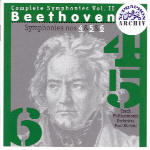Volume 2 of Paul Kletzki’s Beethoven cycle exhibits more of the special virtues found in Vol. 1. Symphony No. 4 especially benefits from Kletzki’s clear-textured approach, which utilizes the special distinctive timbres of the Czech Philharmonic to illuminate Beethoven’s telling orchestration, much in the way Eugen Jochum did with the Concertgebouw Orchestra in his 1960s cycle on Philips. Listen to the lovely clarinet solo in the second movement, and how the colorful woodwinds warmly round off the phrase. A weighty joyfulness informs the remaining movements in this very fine performance. From Beethoven’s grace, we turn to his grit in Symphony No. 5. Despite weak sounding opening chords (which is probably due to the recording), the first movement launches sternly, yet with exceptional rhythmic clarity and sinewy textures that play up the music’s baroque heritage. The ever fresh-sounding Czech winds make the over-familiar second movement a welcome experience. Sharply accented horns punctuate the scherzo, and in the finale Kletzki’s big, open-hearted sonorities underscore the humanity, if not the forcefulness, of Beethoven’s triumph.
Kletzki takes the Pastorale’s subtitle to heart and presents a very leisurely interpretation–the relaxed tempos in the first two movements evoke an afternoon in a hammock more than a day in the country. While very beautiful, I prefer the more spirited outings of George Szell (Sony) and Leonard Bernstein (Deutsche Grammphon), both of whom offer more vehemence in the “Storm” movement, and a more euphoric finale. However, the uniquely characterful playing of the Czech Philharmonic never allows our focus to drift. This goes for Kletzki’s dramatically flowing Coriolan overture as well. Supraphon’s 1960 recordings have transferred exceptionally well, relaying the special sonic attractiveness of the Rudolfinum. This is Beethoven from the “good ol’ days”!
































